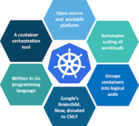Upgrade & Secure Your Future with DevOps, SRE, DevSecOps, MLOps!
We spend hours on Instagram and YouTube and waste money on coffee and fast food, but won’t spend 30 minutes a day learning skills to boost our careers.
Master in DevOps, SRE, DevSecOps & MLOps!
Learn from Guru Rajesh Kumar and double your salary in just one year.
Source:-techhq.com
An overview of the benefits the open-source container technology can bring to businesses.
After many years of cloud native platforms vying for wide industry acceptance, Kubernetes is on the verge of becoming the standard way to create and run agile IT. Its architecture is becoming the de facto standard for rapidly developing, testing, and deploying applications.
Goldman Sachs is one of many banks now exploring open source
Why banking is just now embracing open source technology
The IT outcomes of Kubernetes are clear: 95% of businesses report clear benefits from adopting Kubernetes, with more efficient resource utilization and shorter software development cycles amongst the top benefits cited. The benefits don’t stop with the IT team, though. In an era where IT mostly determines competition and growth, the more agile the technology at the heart of a business, the greater the agility of the business overall.
So, the business case for Kubernetes is clear. To those of us in IT at least.
It makes sense that empowering development teams to do more in less time has clear benefits for businesses on paper. But given the inherent complexity of Kubernetes, the way in which these benefits actually manifest may not be so clear for those outside the IT department, particularly in the early stages of implementing the technology.
Here, we look at why the tangible outcomes Kubernetes can provide across a business are worth overcoming initial challenges it may present, and what it means in the context of global events many organisations have been faced with in 2020 so far.
A newfound sense of agility
Kubernetes works by shifting the focus from building infrastructure to application development. In other words, this means the process of getting the necessary IT infrastructure to build and run applications can be facilitated via a self-service model, one which takes days or even hours rather than weeks or months.
2020 has shown us that being able to react at speed to changing customer behaviour and need ahead of one’s competitors is critical to survival. While this year has been dramatic, that need for speed has always existed in the modern business era. For customer engagement teams, this means a greater level of agility is imperative. Working in small batch processes will allow customer engagement teams to do just that.
By using Kubernetes to make product development and delivery cycles more agile, businesses can build a software development process that more quickly senses and responds to changes in customer behaviour and market shifts, allowing businesses to adapt their technology offering to fit market change. This will allow executive teams to sustainably explore new business opportunities, experiment with the best ways to profit from those ideas, and then continually evolve accordingly.
Accelerating the profitability of a business
In times of global crisis and uncertainty for businesses, prioritising smaller operations processes and shorter batch cycles through adopting Kubernetes will mean businesses’ use of IT becomes faster and more efficient, without breaking the bank.
Kubernetes eliminates the smaller operations processes that would typically slow down application development, while also providing a number of configuration modules which speed up iteration. In practice, this means products can be built, tested, incrementally improved, and delivered to market much faster than before. In contrast, a ‘non-K competitor’ will likely have a harder time evolving their software quickly, and their software supply chain will remain a bottleneck for business growth and innovation.
Moreover, because Kubernetes allows so much to be automated and standardised, resources and innovations can be allocated where needed in more cost-effective ways, boosting efficiencies at a time when businesses need it most.
Sustainable, efficient and flexible paths to competition and growth
Kubernetes is a multi-cloud platform, meaning that it can be run across one or a number of different cloud environments. Businesses therefore have the choice to run Kubernetes clusters in the cloud environment of whichever provider best meets their needs in terms of cost and specification. It also means that, if needed, applications can grow rapidly without having to re-specify and re-architect infrastructure for each new project. Closer to the ground, so to speak, Kubernetes can also be used at the “edge,” in stores, branches, factories, and even jets that need to run software locally.
The ability to more easily allocate time and resources to various aspects of product development on an ongoing basis means that teams are able to incorporate more testing, gather more user feedback, and protect themselves against possible future threats, both business- and security-wise. As a result, the business as a whole is more prepared when challenging times arrive, but as also more adept at functioning in “normal” times.
If anything, the past six months have indicated that businesses can never be too prepared for the future. For infrastructure teams, the pressure is on to consider how they can future-proof their supply chains in the event of another pandemic disrupting global operations again.

 Starting: 1st of Every Month
Starting: 1st of Every Month  +91 8409492687 |
+91 8409492687 |  Contact@DevOpsSchool.com
Contact@DevOpsSchool.com